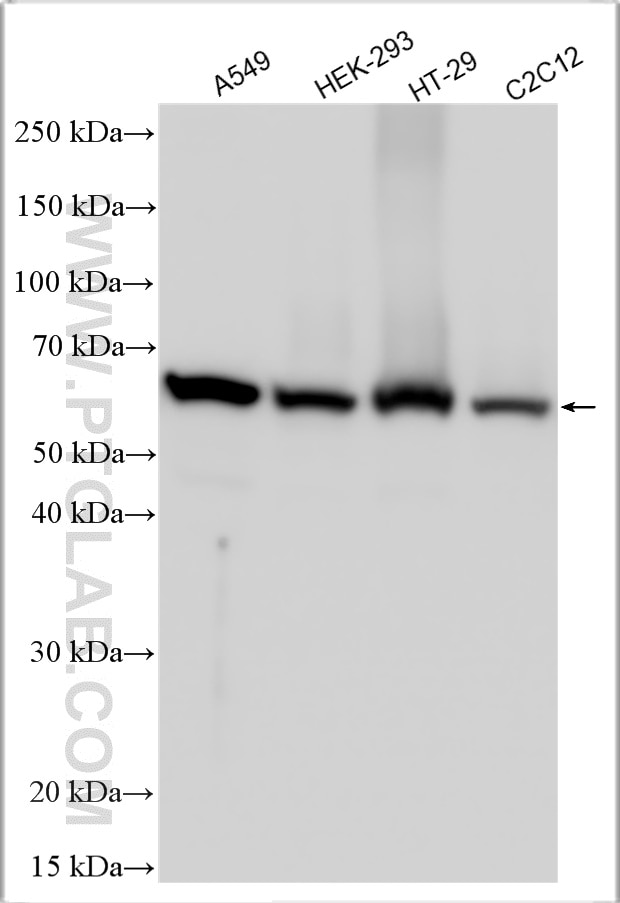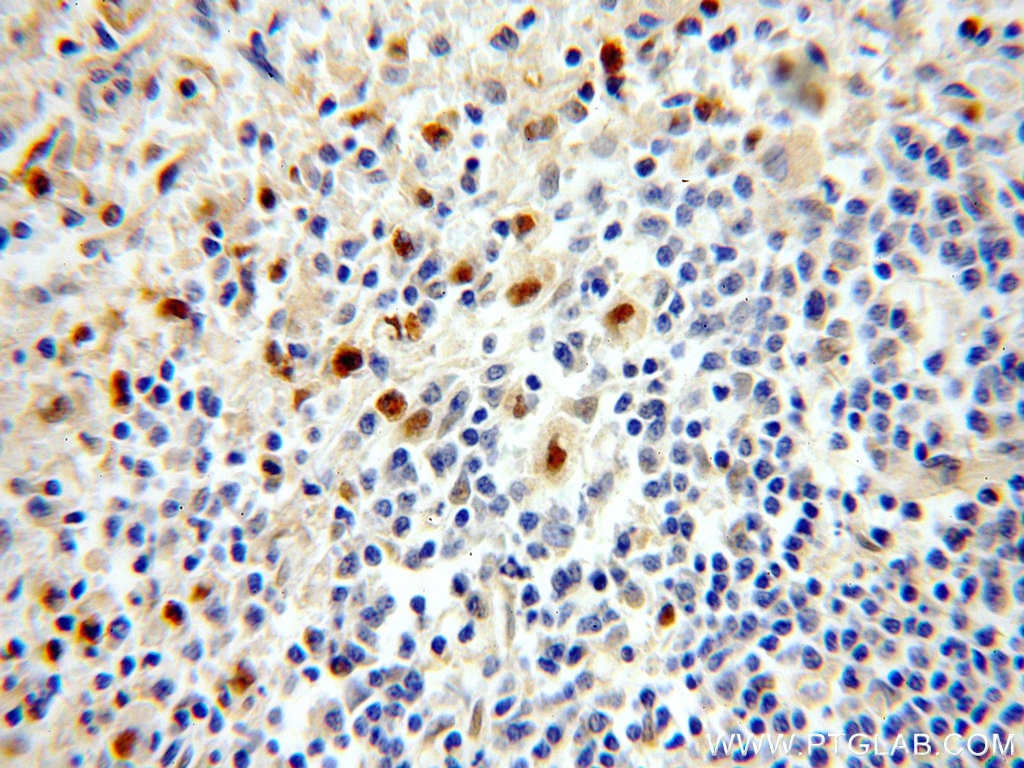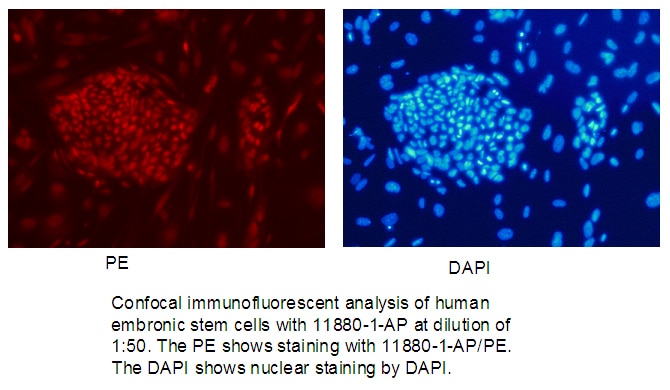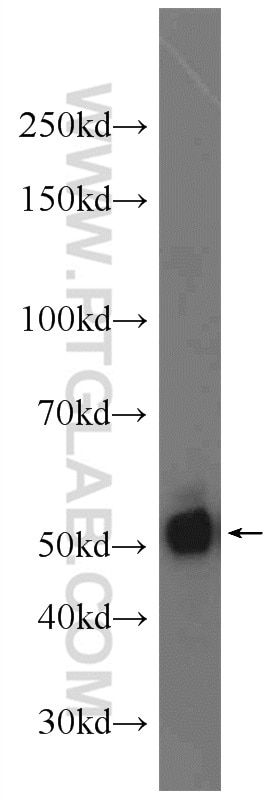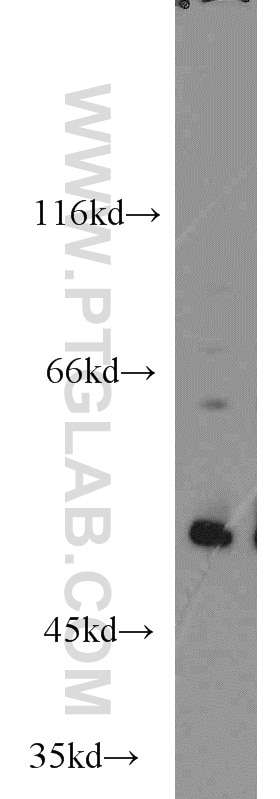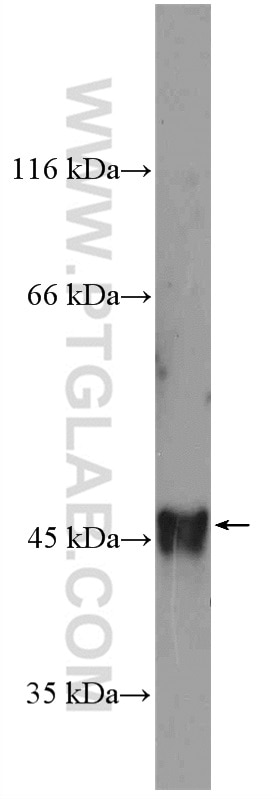- Featured Product
- KD/KO Validated
KLF4 Polyklonaler Antikörper
KLF4 Polyklonal Antikörper für WB, IHC, IF/ICC, FC (Intra), IP, ELISA
Wirt / Isotyp
Kaninchen / IgG
Getestete Reaktivität
human, Maus, Ratte
Anwendung
WB, IHC, IF/ICC, FC (Intra), IP, chIP, ELISA
Konjugation
Unkonjugiert
Kat-Nr. : 11880-1-AP
Synonyme
Galerie der Validierungsdaten
Geprüfte Anwendungen
| Erfolgreiche Detektion in WB | A431-Zellen, A549-Zellen, C2C12-Zellen, HEK-293-Zellen, HeLa-Zellen, HT-1080.Zellen, HT-29-Zellen, HUVEC-Zellen, Mauslebergewebe, Mauslungengewebe, NCCIT-Zellen |
| Erfolgreiche IP | HeLa-Zellen |
| Erfolgreiche Detektion in IHC | Mausembryogewebe, humanes Kolongewebe, humanes Milzgewebe, humanes Tonsillengewebe Hinweis: Antigendemaskierung mit TE-Puffer pH 9,0 empfohlen. (*) Wahlweise kann die Antigendemaskierung auch mit Citratpuffer pH 6,0 erfolgen. |
| Erfolgreiche Detektion in IF/ICC | humane embryonale Stammzellen |
| Erfolgreiche Detektion in FC (Intra) | HeLa-Zellen |
Empfohlene Verdünnung
| Anwendung | Verdünnung |
|---|---|
| Western Blot (WB) | WB : 1:1000-1:8000 |
| Immunpräzipitation (IP) | IP : 0.5-4.0 ug for 1.0-3.0 mg of total protein lysate |
| Immunhistochemie (IHC) | IHC : 1:50-1:500 |
| Immunfluoreszenz (IF)/ICC | IF/ICC : 1:20-1:200 |
| Durchflusszytometrie (FC) (INTRA) | FC (INTRA) : 0.40 ug per 10^6 cells in a 100 µl suspension |
| It is recommended that this reagent should be titrated in each testing system to obtain optimal results. | |
| Sample-dependent, check data in validation data gallery | |
Veröffentlichte Anwendungen
| KD/KO | See 17 publications below |
| WB | See 101 publications below |
| IHC | See 19 publications below |
| IF | See 24 publications below |
| IP | See 5 publications below |
| FC | See 1 publications below |
| ChIP | See 11 publications below |
Produktinformation
11880-1-AP bindet in WB, IHC, IF/ICC, FC (Intra), IP, chIP, ELISA KLF4 und zeigt Reaktivität mit human, Maus, Ratten
| Getestete Reaktivität | human, Maus, Ratte |
| In Publikationen genannte Reaktivität | human, Maus, Ratte |
| Wirt / Isotyp | Kaninchen / IgG |
| Klonalität | Polyklonal |
| Typ | Antikörper |
| Immunogen | KLF4 fusion protein Ag2480 |
| Vollständiger Name | Kruppel-like factor 4 (gut) |
| Berechnetes Molekulargewicht | 504 aa, 54 kDa |
| Beobachtetes Molekulargewicht | 50-60 kDa |
| GenBank-Zugangsnummer | BC030811 |
| Gene symbol | KLF4 |
| Gene ID (NCBI) | 9314 |
| Konjugation | Unkonjugiert |
| Form | Liquid |
| Reinigungsmethode | Antigen-Affinitätsreinigung |
| Lagerungspuffer | PBS mit 0.02% Natriumazid und 50% Glycerin pH 7.3. |
| Lagerungsbedingungen | Bei -20°C lagern. Nach dem Versand ein Jahr lang stabil Aliquotieren ist bei -20oC Lagerung nicht notwendig. 20ul Größen enthalten 0,1% BSA. |
Hintergrundinformationen
The mammalian Krüppel-like transcription factor 4 (Klf4) is an evolutionarily conserved zinc finger-containing transcription factor with diverse regulatory functions in cell growth, proliferation, differentiation and embryogenesis. It also plays a significant role in the process of tumorigenesis. Klf4 is one of the key transcription factors that have been used to reprogram mouse and human fibroblasts to a pluripotent state also called induced pluripotent stem (iPS) cells. Affinity purified rabbit anti- Klf4 is for the detection of Klf4 transgene expression in the process of reprogramming. There are two isoforms of KLF4 (PMID: 15561714), with MW range from 50 to 60 kDa,and major band is 55 kDa. KLF4 protein can be ubiquitin modified.
Protokolle
| Produktspezifische Protokolle | |
|---|---|
| WB protocol for KLF4 antibody 11880-1-AP | Protokoll herunterladen |
| IHC protocol for KLF4 antibody 11880-1-AP | Protokoll herunterladen |
| IP protocol for KLF4 antibody 11880-1-AP | Protokoll herunterladen |
| FC protocol for KLF4 antibody 11880-1-AP | Protokoll herunterladen |
| Standard-Protokolle | |
|---|---|
| Klicken Sie hier, um unsere Standardprotokolle anzuzeigen |
Publikationen
| Species | Application | Title |
|---|---|---|
Nat Commun Klf4 glutamylation is required for cell reprogramming and early embryonic development in mice. | ||
Nat Commun LncBRM initiates YAP1 signalling activation to drive self-renewal of liver cancer stem cells. | ||
J Hematol Oncol A novel lncRNA ROPM-mediated lipid metabolism governs breast cancer stem cell properties. | ||
Mater Today Bio Cellular reprogramming with multigene activation by the delivery of CRISPR/dCas9 ribonucleoproteins via magnetic peptide-imprinted chitosan nanoparticles. | ||
EMBO J Fatty acid synthesis is critical for stem cell pluripotency via promoting mitochondrial fission. | ||
J Neuroinflammation The critical role of KLF4 in regulating the activation of A1/A2 reactive astrocytes following ischemic stroke |




